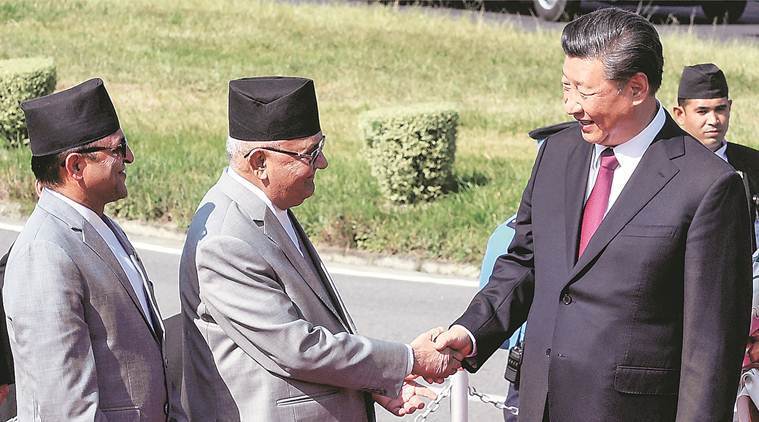- India
- International
China’s dramatic rise in the 21st century makes Beijing a far more compelling partner for Kathmandu
India must recast relations with Nepal on basis of geographic and cultural interdependence, sovereign equality and mutual benefit.
 Chinese President Xi Jinping with Nepal PM K P Sharma Oli in Kathmandu earlier this month. (Reuters Photo)
Chinese President Xi Jinping with Nepal PM K P Sharma Oli in Kathmandu earlier this month. (Reuters Photo)
President Xi Jinping’s recent visit to Kathmandu has helped focus on the changing dynamic between India, China and Nepal. One of the central themes in the new discourse is the alleged loss of Indian “hegemony” over Nepal. The proposition, however, is based on questionable assumptions. The story of Nepal’s geopolitics is a complicated one. India’s hegemony or primacy in Nepal is somewhat over-stated. It was limited in time and space and always constrained by Nepal’s domestic politics.
Lodged between Tibet and the Gangetic plain, Nepal has close civilisational ties with both China and India. Its geopolitics, too, were shaped by both the neighbours. Prithvi Narayan Shah, who unified Nepal at the end of the 18th century, famously described Nepal’s strategic condition as a “yam between two rocks”.
Balancing between Tibet and the Qing empire in the north and British Raj in the south was very much part of modern Nepal’s political evolution. It was only with the weakening of the Qing and the rise of the Raj from the mid-19th century that set the stage for southern dominance over Nepal. But it was not going to last forever.
When the People’s Republic of China gained control of Tibet in 1950, Nepal’s monarchy that was frightened by the communist threat turned to Jawaharlal Nehru for protection. Delhi and Kathmandu revived the 19th century security arrangements of the British Raj in a 1950 Treaty of Friendship. China’s premier Zhou Enlai was quick to assure Kathmandu that there would be no export of communist revolution from Tibet to Nepal. The Sino-Indian conflict, meanwhile, opened up space for Kathmandu to weaken the treaty arrangements with India and re-balance the relationship. Nepal’s strategy is made messier by the deepening domestic divisions on what constitutes the country’s “national interests”.
To cut this long and complicated story short, Delhi has struggled since the middle of the 20th century to sustain the primacy in Nepal it had inherited from the Raj. The emergence of a strong state north of the Himalayas tested India’s claim for an exclusive sphere of influence in Nepal. China’s dramatic rise in the 21st century makes Beijing a far more compelling partner for Kathmandu.

India’s failure was not in an over-reliance on geopolitics, but the neglect of geoeconomics. While the security establishment and the political classes operated as if Nepal was a protectorate of India, Delhi’s economic bureaucracy treated Nepal as a separate entity. Delhi’s emphasis on economic autarky meant there was no special value attached in India to the commercial interdependence with land-locked Nepal, let alone nurture it.
Vested interests inevitably found space to arbitrage the wide gap in the economic policies of the two nations. Delhi also allowed the border infrastructure to rot over the decades. Delhi’s attempts to revive connectivity with Nepal in recent years have run into India’s traditional problems with project implementation. Even more important, there has been growing political resistance in Kathmandu to deeper economic relations.
Put simply, the change in the regional balance and the communist dominance over Nepal’s domestic politics means the old rules don’t apply any more in the triangular relationship.
In the past, China sounded sensitive to India’s concerns in its engagement with Nepal. As the second most important power in the world and the foremost in Asia, China perhaps is a lot less interested in what Delhi might think about its Nepal policy. Above all, China today is driving regional change with its expansive Belt and Road Initiative.
On the face of it, Kathmandu has at least three possible options in crafting a new strategy for Nepal. One is to opt for neutrality and symmetry in its relations with India and China. This is not a new idea and was reflected in Kathmandu’s past debates about “Nepal as a Zone of Peace”. Second, it could decide that a special relationship with China is more valuable than the one with India. Third, it could continue a policy of dynamic balancing and make the best of the possibilities with both China and India.
If Nepal opts for strict symmetry, it would have to turn its open border with India into a closed one similar to its northern frontier with China. A considered strategic tilt towards China means Kathmandu would want to discard the special privileges it has in the relationship with Delhi, for example, the freedom for Nepali citizens to live and work in India. Nepal’s sovereign choice would also involve an assessment of the inevitable Indian counter measures to a strong security partnership between Beijing and Kathmandu. The third option would involve modernisation of the India relationship and expansion of the China ties with sufficient regard to the concerns of both the powers. Nepalese have often talked about becoming a “bridge” between the two nations. But the economic, political and security implications of what it might mean to be a bridge remain to be fleshed out.
For India, it is time stop whining about China’s growing presence in Nepal or lamenting the loss of much-vaunted primacy in Nepal. The protectorate relationship that Delhi inherited from the Raj was never sustainable. Nor was the air of strategic condescension in Delhi. Nothing infuriates the Kathmandu elite more than Delhi’s claim to know what is good for Nepal. Delhi does not. Instead, Delhi should let Nepalese decide what is good for them and tailor India’s own responses accordingly.
India has had its share of strategic errors in dealing with Nepal. The best corrective Delhi can offer is a new compact with Nepal that can build on the natural geographic and cultural interdependence between the two nations. This time around it must be based on sovereign equality and mutual benefit. It is up to Kathmandu in the end to accept, reject or negotiate on such an offer.
This article first appeared in the print edition on October 22, 2019 under the title ‘A more equal friendship’. The writer is director, Institute of South Asian Studies, National University of Singapore and contributing editor on international affairs for The Indian Express.
EXPRESS OPINION
More Explained
Apr 19: Latest News
- 01
- 02
- 03
- 04
- 05









































